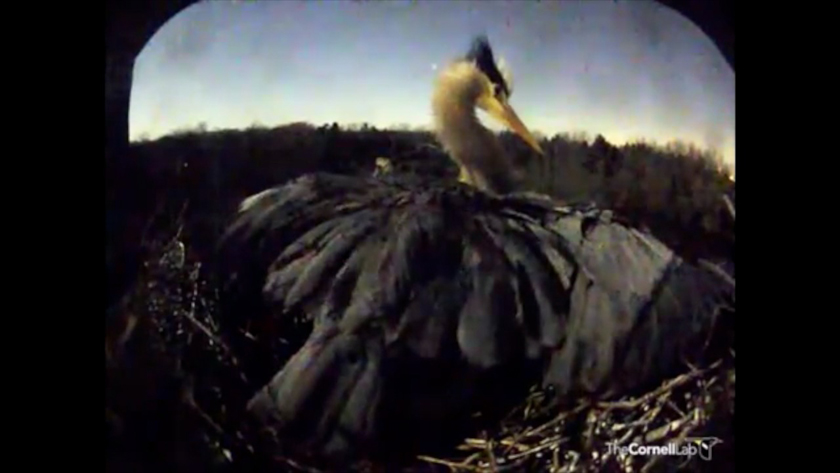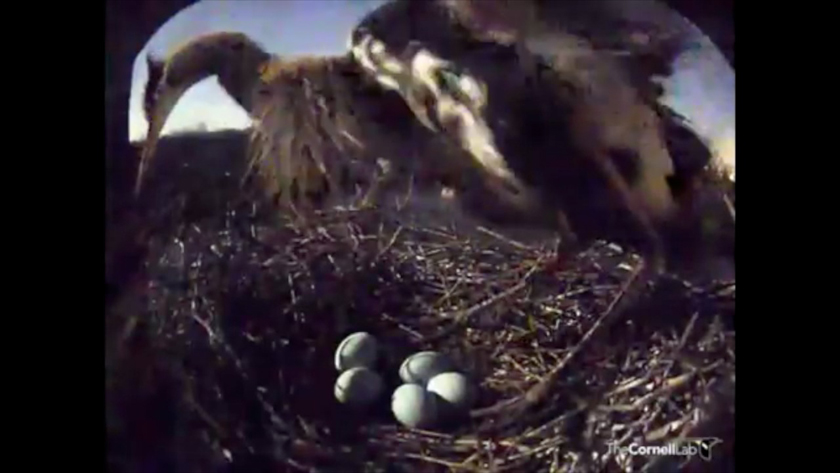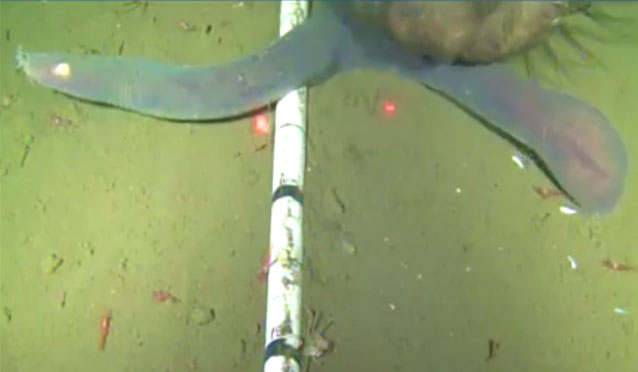The Citizen Science Of Critter Cams
Critter cams can add data to the scientific literature, make citizen scientists out of lots of armchair naturalists, and may help keep endangered species safe from poachers.
By Vicki Croke
Have you ever seen a great horned owl attack a great blue heron by moonlight? Well, if you are one of the 8 to 10 million people who have tuned into the live-streaming bird cams set up by the renowned Cornell Lab of Ornithology in New York, chances are that you have.
Charles Eldermire, Bird Cams Project Leader at the Cornell Lab of Ornithology, chose a few of his favorite moments for WBUR’s Here & Now. A great horned owl attacking a great blue heron and an albatross courting dance are among the selections.
[youtube=http://youtu.be/UO0KqCzWd_4]
Critter cams are those high-tech, often HD cameras trained on animals, wild and tame– everything from cockroaches to corgis to giant pandas. And the images are streamed onto the Internet 24 hours a day.
A dreamlike image from great blue heron nest cam footage. Courtesy of Cornell Lab of Ornithology.

They are often, even at their most humdrum, wildly popular.
But the dramatic clash between the owl and heron captured by Cornell wasn’t just crowd-pleasing, it did something else.
It turns out that critter cams, like this one, can add data to the scientific literature, make citizen scientists out of lots of armchair naturalists, and may help keep endangered species safe from poachers.
Cornell has been placing cameras in the nests of several species of bird in different locations since 1998. They’ve got high-def cameras with incredible audio and even technology for capturing those images at night. Herons are spectacular birds—they look like ballet dancers, but are, in fact, formidable predators. It’s tough to see into their huge nests made of sticks that can be 2 feet deep and 40 to 80 feet high in a tree. But this camera, mounted right over the nest, gave a clear, close-up window on the lives of a mated pair.
The moment a great horned owl hit a female great blue heron on her nest. Courtesy of Cornell Lab of Ornithology.

One night, something happened that scientists knew occurred in nature, but had never recorded in such dramatic detail: A predator of the night attacked a predator of the day: owl versus heron.
I spoke via Skype with Charles Eldermire, who runs the bird cam program, and he described the scene in detail:
“And then just to have, literally, in the click of an instant…we have this pale shape just BOMB IN! hit the heron—you couldn’t see exactly what was happening, but all of a sudden everything went black because the heron was up against the camera and she came off and puffed up like a giant, prehistoric…bird, all shaggy and pointed and just SCREAMED.”
This vocalization from the great blue heron had never been recorded before. And Charles Eldermire told me something interesting about that:
“The vocalization that that heron made following the attack is something our Macaulay Library of sound and video does not have on record. They have hundreds of thousands of recordings, but they do not have that recording. That, in and of itself, is a new point of scientific data. However, the reason we knew that it even happened was because somebody was sitting there and watching and listening at 3 in the morning…”
Critter cams may turn people who watch endless hours of animal behavior (and flag the good stuff) into citizen scientists.
The heron repositions herself on her eggs after the owl attack. Courtesy of Cornell Lab of Ornithology.

It might be small details. So far critter cam watchers aren’t publishing papers in the journal Nature, but they are helping to fill in the dots of animals’ lives and connecting those dots provides us with a fuller picture.
For Cornell, several viewers or “chatters” actually devised a Google spreadsheet to help the scientists track the prey items consumed by a pair of red-tailed hawks in the nest.
There are critter cams all over, so there are millions of hours of animal behavior being recorded.
And who is keeping an eye on all of that? There are so-called data mining software programs, but as one Canadian scientist said, the best data miners are citizens like you! That’s millions of people all over the world.
There may not be a wave of amateur sightings of important, science-changing observation, but we do have some.
My favorite involved a teenager in Ukraine—Kirill Dudko– who was home watching a live stream feed from a camera on the sea floor in the Pacific Ocean, near Vancouver Island, being run by the University of Victoria, which operates Ocean Networks Canada.
He saw an underwater monster and emailed the clip to the science director, Kim Juniper for an explanation.
Juniper contacted biologists up and down the coast.
An elephant seal sucks up a hagfish. Courtesy of Ocean Networks Canada.

It turned out to be a female elephant seal eating a hagfish. And the video went viral because it provided something new to the experts.
I spoke this week to Dr. Juniper and he explained the significance to those who study elephant seals:
“Scientists had known that they can dive to this depth because they’ve glued sensors to their backs that have recorded, and we know they can go this deep. And from analyzing the stomach contents of dead individuals we find on the beach, we knew that they fed on hagfish but no one had ever observed them feeding like this under water before so it was quite exciting for scientists involved to have confirmation that they do feed on hagfish at depth and this is the technique that they use.”
Some people worry that there’s a danger with these critter cams: viewers sometimes become overly attached to the animals they watch and want to disrupt the course of nature and intervene to keep them safe.
Many of us feel that people caring about animals is a good thing. And at Cornell, Charles Eldermire says that it rarely becomes an issue simply because the Lab’s live-feeds are moderated by experts who fill viewers in on what’s happening and why. If a predator’s dead offspring is consumed by the living members of the family—that’s natural and the moderators explain that. They also place a screen over the picture, and post a warning for viewers before they go on, if something like that is taking place. Viewers can choose to go ahead and view the flagged scene.
On the other hand the Lab’s policy is that if a bird is put in danger by a man-made cause, then they will intervene. And that happened last year when an osprey chick got tangled in fishing line that had been to line the nest. Viewers spotted the problem and a bucket truck was there within hours to help.
Critter cams may end up keeping animals safe in another way. So far, I don’t know of any live streams broadcast to the internet that are being used specifically to keep endangered species safe from poachers, but the potential is there. A few wildlife groups are planning to use unmanned aerial drones with cameras to monitor populations of endangered animals. One reserve in Kenya is hoping to do this to save rhinos.
And just this week, I spoke to Alan Rabinowitz, who is perhaps the world’s leading expert on big cats. He runs an organization called Panthera, which helps protect wild cats like tigers, leopards, and lions around the world. And he’s just received $80 million in a campaign which hopes to raise $200 million or more.
He told me that they’d never have enough so-called “boots on the ground”—soldiers protecting wildlife– to be truly effective, and that cameras could fill the gap:
“The only answer in the future is going to be technology. Technology that we’ve adapted from other parts of human civilization like traffic cameras that we’ve now adapted into something called “poacher cams.” We’re scaling up in order to put cameras in the forest not just to take pictures of animals and be able to identify and count animals but to take pictures of people. Cameras that don’t flash, where the people won’t even know where the camera is or when their picture is taken until there’s a knock on their door or until law enforcement arrives in their village.”
I think participating in virtual poacher patrols would be something lots of people would love to do. And it comes down to what all the scientists I’ve spoken to have talked about: All of these cameras are producing endless hours of footage—the eyes of the world can help scan all of it.
Here are two nests currently with young:
[mashshare]

2 Responses to “The Citizen Science Of Critter Cams”
“I think participating in virtual poacher patrols would be something lots of people would love to do.”
I know it! I visit some of the Wild Earth cams when I have time and my fellow ‘pondies’ (as we call ourselves at Pete’s Pond in Botswana – we chat on the ustream feed) are passionate about protecting the rhinos, elephants and lions.
Not a one of them wouldn’t jump at the chance to help the critters.
11:00 PM September 11, 2016
Just a few minutes ago my wife and I heard a terrifying screech that could only have been our resident Great Blue Heron whom we’d begun referring to as Fred. I followed where the sound came from and just a few feet away there was Fred in a heap on the grass. We realized he was still breathing so we decided to try and get him to the emergency Vet. He was still breathing, but in bad shape. I felt to see if he was choking on something but no obstruction. I kept his head elevated but within a few minutes he was gone. My wife stopped the truck and turned on the lights and said “He’s bleeding!” Sure enough he was wounded in the middle of his neck.
We’ve seen the owl around this time of night when we were outside by the pool. A couple of different times recently he flew right over our head silently and was gone back into the night. We live near a wildlife refuge and we get lots of animal traffic but this was personal, having come to love the big bird who had gotten more and more comfortable eating the catfish in our pond.
We will miss Fred and be a lot more careful having our little dog out at night.
TS
Comments are closed.